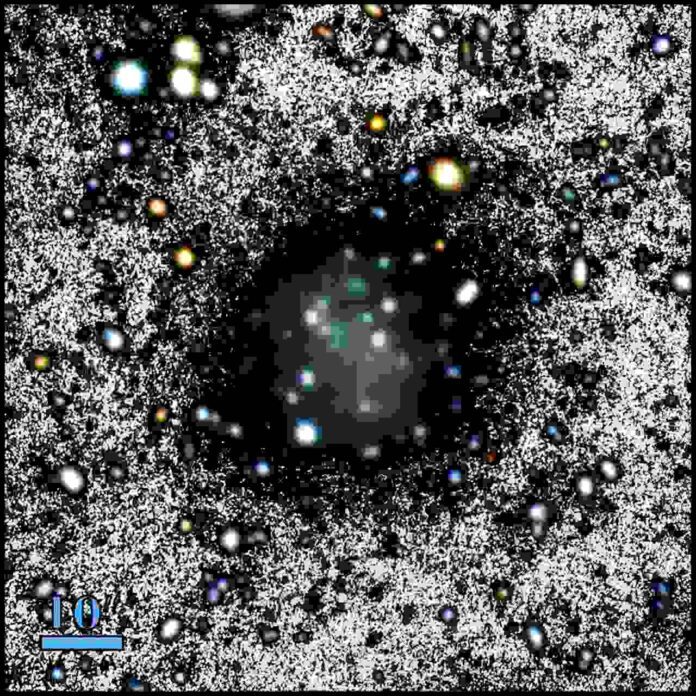The universe is a vast expanse of wonders, with countless galaxies and celestial objects that captivate the human imagination. However, there is a hidden realm that astronomers have been exploring—the world of almost dark galaxies. These enigmatic structures, which possess extremely low surface brightness, have remained elusive to our observations for a long time. In this article, we will dive into the fascinating discoveries made by scientists in the realm of almost-dark galaxies and their implications for our understanding of the cosmos.
To comprehend the significance of almost-dark galaxies, we must first grasp the concept of dark matter. According to scientific models, dark matter constitutes a staggering 26% of the universe, surpassing the amount of ordinary matter that we can observe. Despite its prevalence, dark matter remains elusive as it does not interact with light, rendering it essentially unobservable. However, its presence can be inferred through its gravitational effects on visible matter.
Throughout history, astronomers have encountered dark galaxies when they observed peculiar phenomena such as gas clouds exerting unexplained gravitational forces on other celestial structures. These elusive galaxies lack an unambiguous optical counterpart, making them challenging to detect using traditional survey methods. However, recent advancements in observational techniques have allowed astronomers to uncover some of these hidden gems.
In 2016, astronomers made a groundbreaking discovery with the identification of the Dragonfly 44 Ultra Diffuse Galaxy (UDG). Despite its massive size, comparable to our Milky Way, Dragonfly 44 lacks the usual bright stars and recognisable galactic structure. Further investigation revealed that the majority of its mass is composed of dark matter, solidifying its status as an almost-dark galaxy.
While fully dark galaxies remain a challenge to confirm, there are galaxies that come close to this definition due to their limited luminosity. These “near-dark galaxies” are rare and often contain a substantial amount of dark matter. Scientists have recently identified a remarkable candidate in this category – the intriguing galaxy known as Nube.
The Discovery of Nube: An Almost Dark Marvel
The discovery of Nube was made possible through an analysis of data from the IAC Stripe 82 Legacy Project. This project focuses on researching a specific area of the sky that the SDSS Telescope imaged, offering a wealth of knowledge about faint surface brightness astronomy.
Nube, a galaxy approximately 10 billion years old, has captured the attention of astronomers due to its unique properties. With a half-mass radius of 22,500 light years, Nube is three times larger than a typical ultra-diffuse galaxy. Its extremely low optical emissions give it a surface brightness of only 26.75 mag/arcsec2, making it ten times fainter than regular UDGs, which are already among the dimmest observable galaxies.
Despite its size, Nube has a stellar mass of approximately 390 million times that of our Sun. In comparison, the Milky Way, with all its luminosity, is about 3,800 times more massive than this near-dark galaxy. However, it is important to note that even typical UDGs typically have only 1% as many stars as our home galaxy, highlighting the vast difference in stellar densities.
The discovery of Nube has sparked intriguing discussions among scientists regarding its origin and nature. Is the unique combination of properties observed in this galaxy a result of its original formation, or did environmental factors play a role in shaping its characteristics? A closer examination of Nube’s stellar distribution has provided some fascinating insights into these questions.
By assuming that the distribution of stars in Nube represents the distribution of the underlying dark matter halo, researchers have found that a soliton-shaped profile, typical of fuzzy dark matter, closely matches the observed distribution of stars. This finding raises intriguing possibilities regarding the nature of nubes and suggests a potential connection between their properties and the nature of dark matter.
The Implications of Almost Dark Galaxies
The discovery and study of almost dark galaxies like Nube provide valuable insights into the hidden aspects of the universe. By shedding light on these enigmatic structures, scientists can refine their understanding of galaxy formation, the role of dark matter, and the intricate web of cosmic evolution.
Dark matter remains one of the most significant mysteries in modern astrophysics. The study of almost dark galaxies offers a unique opportunity to probe the nature of dark matter and its influence on the formation and evolution of galaxies. The fascinating correlations between the distribution of stars in Nube and the hypothetical soliton-shaped profile of fuzzy dark matter open new avenues for exploration.
The discovery of Nube and other almost-dark galaxies paves the way for further research and exploration. Advanced observational techniques, combined with theoretical modelling, will enable scientists to uncover more of these hidden treasures and deepen our understanding of the cosmos.
The realm of almost-dark galaxies has captivated astronomers with its mysterious allure. These galaxies, with their low surface brightness and hidden properties, offer a unique window into the unseen aspects of the universe. With ongoing research and advancements in technology, scientists are unravelling the secrets of almost dark galaxies, expanding our knowledge of galaxy formation, dark matter, and the intricate tapestry of cosmic evolution. As we continue our exploration of the cosmos, these hidden marvels will undoubtedly uncover new revelations, inspiring awe and wonder for generations to come.
Reference:
Mireia Montes et al, An almost dark galaxy with the mass of the Small Magellanic Cloud, arXiv (2023). DOI: 10.48550/arxiv.2310.12231
